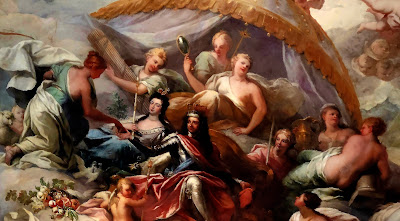Diseñado a principios del
siglo XVIII por Sir James Thornhill, Painted Hall cuenta
con 40,000 pies cuadrados de paredes y techos barrocos. Estas superficies
están cubiertas de impactantes imágenes que representan 200 figuras, incluidos
reyes, reinas y criaturas mitológicas.
Originalmente
se pensó como un espacio para comer para los pensionistas de Greenwich que
vivían en el Royal Hospital, como se llamaba entonces, pero pronto se convirtió
en una atracción turística y solo se usaba para cenar en ocasiones especiales.
La pintura épica de Sir James Thornhill se basa en un
elenco de alrededor de 200 figuras para contar una increíble historia de cambio
político, logros científicos y culturales, esfuerzos navales y empresas
comerciales, todo ello en una serie de magníficos telones de fondo. Los
personajes que incluyó son una mezcla de alegóricos, mitológicos, históricos y
contemporáneos.
La narrativa central se centra en un momento crucial cuando
se creó el Reino Unido y se convirtió en una potencia dominante en
Europa. Las pinturas celebran la estabilidad política, la prosperidad
comercial y el poder naval de Gran Bretaña. También representa las
adhesiones protestantes al trono del rey Guillermo III y la reina María II en
1688 y Jorge I en 1714.
Sir James Thornhill (1675-1734) fue un pintor inglés de acontecimientos históricos que trabajó en un estilo barroco italiano. Pasó 19 años planificando y pintando el magnífico Painted Hall y fue bien recompensado por sus esfuerzos. Le pagaron una libra por cada yarda -alrededor de un metro cuadrado- en las paredes y tres libras por lo mismo en el techo. Eso llegó a un total de £ 6,685, alrededor de £ 1,4 millones en dinero de hoy. También fue el primer artista inglés en ser nombrado caballero en 1720 por Jorge I.
Designed in the early eighteenth century by Sir James Thornhill,
Painted Hall features 40,000 square feet of Baroque walls and ceilings. These
surfaces are covered in striking images depicting 200 figures, including kings,
queens, and mythological creatures.
It was originally
intended as a dining space for Greenwich pensioners living in the Royal Hospital,
as it was then called, but it soon became a tourist attraction and was only used
for dining on special occasions.
Sir James Thornhill's
epic painting draws on a cast of around 200 figures to tell an incredible story
of political change, scientific and cultural achievements, naval endeavors and commercial
ventures, all set against a series of magnificent backdrops. The characters
he included are a mixture of allegorical, mythological, historical and contemporary.
The central
narrative focuses on a pivotal moment when the UK was created and became a dominant
power in Europe. The paintings celebrate Britain's political stability,
commercial prosperity and naval power. It also represents the Protestant adhesions
to the throne of King William III and Queen Mary II in 1688 and George I in 1714.
Sir James Thornhill (1675–1734) was an English painter of historical events who worked in an Italian Baroque style. He spent 19 years planning and painting the magnificent Painted Hall and was well rewarded for his efforts. He was paid one pound for every yard — about a square meter — on the walls and three pounds for the same on the roof. That came to a total of £6,685, around £1.4 million in today's money. He was also the first English artist to be knighted in 1720 by George I.


































































































